Starting a balanced diet means making smart choices. The Eatwell Guide and USDA’s “ChooseMyPlate” show us how. Aim for 5 daily portions of fruits and veggies, with half your plate colorful.
For energy, choose whole grains like brown rice and quinoa. Include lean proteins like salmon or beans. Dairy or fortified plant-based milk, in moderation, is good for bones. Drink plenty of water and cut down on sugary drinks.
Key Takeaways
- Include 5 portions of fruits/vegetables daily (e.g., 80g fresh, 30g dried fruit).
- Fill half your plate with fruits and vegetables at each meal.
- Choose whole grains like oats or barley instead of refined options.
- Eat 2 weekly fish portions, including oily fish like salmon for omega-3.
- Limit added sugars and saturated fats to reduce heart disease risks.
Eating well reduces chronic diseases and boosts energy. The NHS’s 12-week plan and USDA guidelines help track your progress. Start with small changes, like drinking water instead of soda or choosing whole grains. These steps lead to a lasting healthy eating habit.
Fruits and Vegetables: Include a variety of colors and types (aim for five portions a day) for vitamins, minerals, and fiber
Adding colors to your plate is not just pretty—it’s good for you. Nutrient-rich foods like fruits and veggies give you vitamins, fiber, and antioxidants, which help fight off diseases. Try berries on oatmeal, carrot sticks as snacks, and leafy greens in dinners to get your five servings a day.
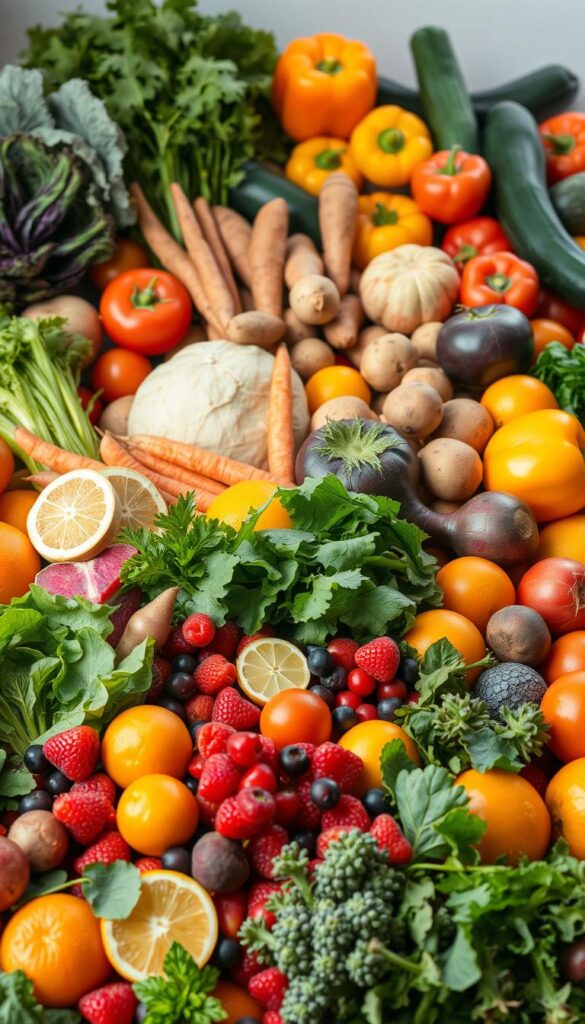
Why Color Variety Matters
Each color has its own health benefits. Here’s how to mix them:
| Color Group | Examples | Key Nutrients |
|---|---|---|
| Red/Orange | Carrots, tomatoes, sweet potatoes | Lycopene, beta-carotene |
| Green | Spinach, broccoli, peas | Folate, iron, vitamin K |
| Blue/Purple | Blueberries, eggplant, grapes | Anthocyanins |
“Eating five daily portions lowers heart disease risk by 4% per serving,” says a study tracking 469,551 participants.
Getting your portions is easy: one apple, half a cup of cooked spinach, or a handful of grapes. Even frozen or canned options work; just watch for added sugars or sodium. Try roasted sweet potato wedges instead of fries, or mix greens with berries in salads. Every bite of nutrient-rich foods helps your health in the long run. Your colorful plate could be saving your health!
- Dark green: 2 cups raw or 1 cup cooked (kale, bok choy)
- Red/orange: 1 cup chopped or 1 large pepper
- Beans/legumes: 1/2 cup cooked (lentils, chickpeas)
Color-coding meals boost fiber and reduce disease risks. Pick frozen berries for smoothies, add spinach to eggs, or grill a mix of veggies for a healthy side. These steps lead to a healthier you.
Proteins: Opt for lean meats, fish, eggs, beans, nuts, and legumes to aid muscle repair and growth
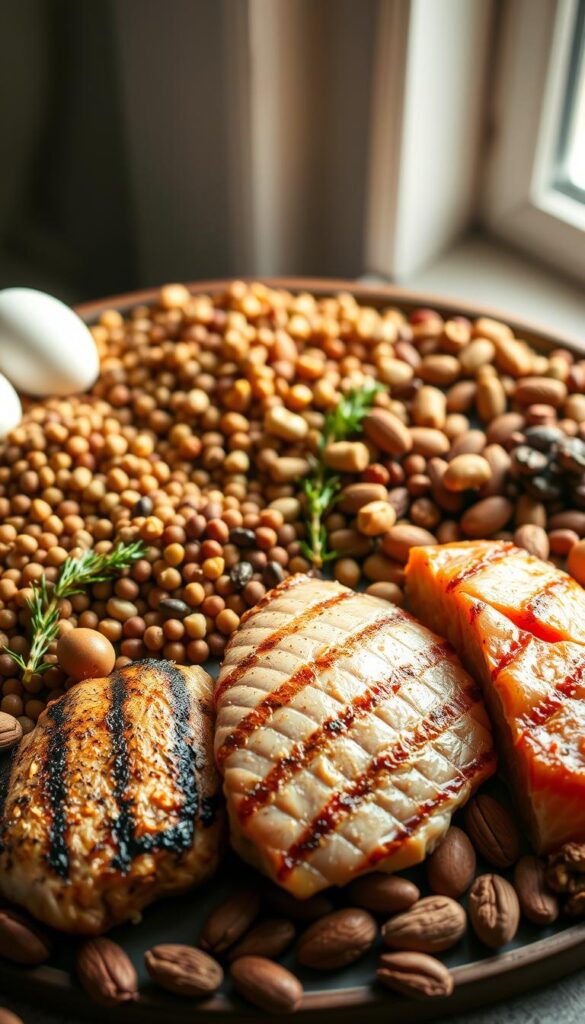
Starting a dietary balance means picking the right proteins. The USDA says adults should eat 5–7 ounces of protein each day. This depends on how many calories you need. Proteins help grow muscles, fix tissues, and boost your immune system.
A 165-pound person needs about 60 grams of protein every day. With the right choices, this can be easily obtained.
Plant vs. Animal Protein Sources
Animal proteins like chicken breast and Greek yogurt have all the amino acids you need. Choose lean meats like pork tenderloin or skinless turkey to avoid too much fat. Seafood is great, too, especially fatty fish like salmon for omega-3s and shrimp for 22g of protein per 3 oz.
Plant proteins are full of fiber and have no cholesterol. A ½ cup of cooked lentils has 9g of protein, and tofu has 8g per 3 oz. Mixing beans, nuts, and quinoa ensures you get all amino acids. For example, lentils and almonds together make a complete protein.
- Animal sources: Chicken, fish, eggs (3.6g protein per white)
- Plant sources: Beans (20–25g per ½ cup), edamame, and nuts
Mix both animal and plant proteins in your meals. Add 2 tbsp of peanut butter (8g protein) for snacks. Choose 95% lean beef or bison for burgers to cut down on fat. Remember, a deck-of-cards-sized steak is about 3 oz of protein. Aim for variety to meet your body’s needs without too much fat.
Whole Grains: Choose brown rice, oats, whole wheat pasta, and quinoa for fiber and stable energy levels
Well-balanced meals start with whole grains, which give you steady energy and nutrients. Brown rice, oats, and quinoa are great choices because they retain all the nutrients of the grain.
Whole grains digest slowly, which helps prevent blood sugar spikes. Eating three servings a day can lower heart disease risk by 22%. Switching to whole grains can also reduce inflammation and improve digestion.
- 3 grams of fiber per ounce from oats aids digestion
- Whole grain eaters have a 14% lower stroke risk compared to those who avoid them
- B vitamins in grains support energy production and nerve function
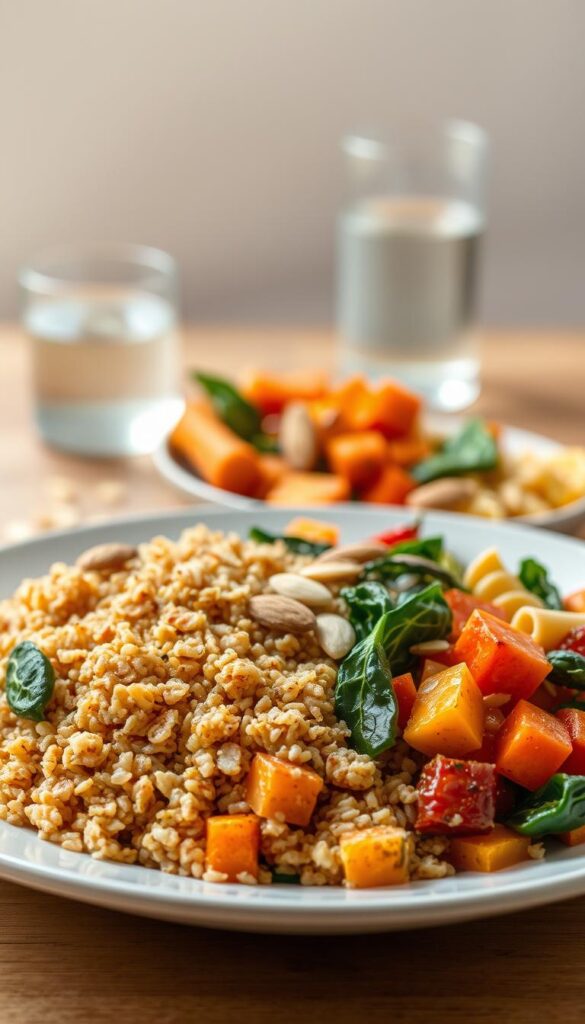
Benefits of Complex Carbohydrates
Government guidelines suggest eating at least half whole grains. Here’s how to meet daily targets:
| Age Group | Total Grains (oz) | Whole Grains (oz) |
|---|---|---|
| Adult Women | 5-7 | 3-3.5 |
| Adult Men | 6-10 | 3-5 |
| Teens | 6-10 | 3-5 |
Check for “whole” on labels to ensure you’re getting the real deal. Try whole-wheat pasta or add quinoa to your meals. Each 1-ounce serving can lower mortality risk by 5%. Whole grains are key to meals that keep you going all day.
Dairy or Dairy Alternatives: Incorporate milk, cheese, yogurt, or fortified plant-based alternatives for calcium and protein
Most Americans don’t get enough dairy, and 90% don’t get enough calcium. A good nutrition plan includes 2-3 servings of dairy or alternatives each day. Toddlers need 1½ to 2 cups, while adults need 3 cups. Choose milk, yogurt, and cheese to support strong bones and muscles.
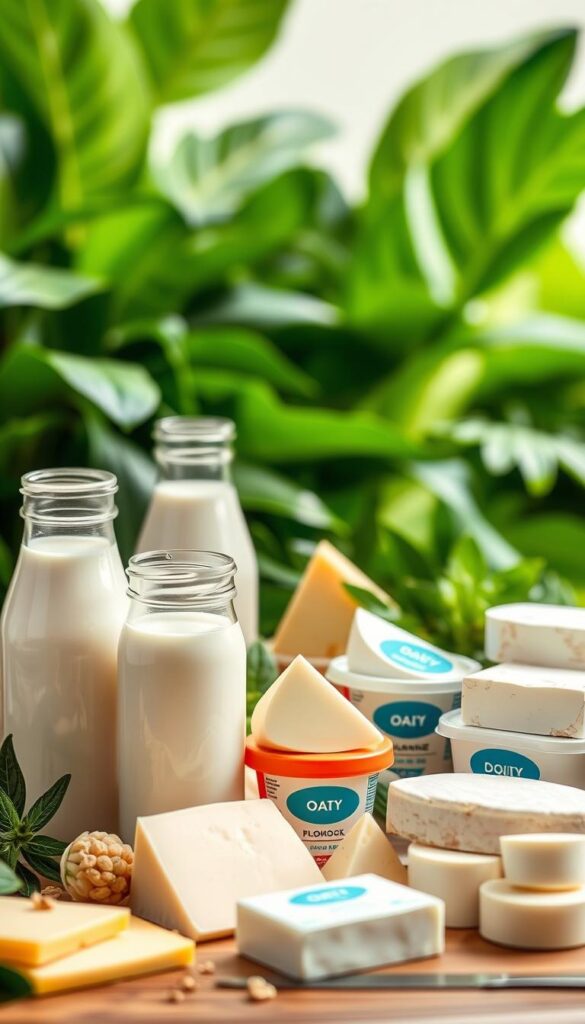
- Low-fat milk (1% or skim) to cut saturated fats
- Plain Greek yogurt (double protein of regular yogurt)
- Reduced-fat cheeses like cheddar (16g fat/100g) over high-fat options
- Unsweetened, calcium-fortified plant-based milk (soy, almond, or oat)
Prioritize Fortified Options for Allergies or Lactose Intolerance
For those avoiding dairy, soy milk (7g protein/cup) or almond milk (39 calories/cup) are good choices. Always check labels for calcium and vitamin D. Lactose-free dairy products are great for sensitive stomachs.
Infants under 12 months shouldn’t drink cow’s milk, but older children can enjoy reduced-fat options. Vegans can meet calcium needs with fortified plant-based yogurts and cheeses. When building your nutrition plan, pair dairy or alternatives with meals. Add cottage cheese to salads, mix yogurt into smoothies, or sprinkle low-fat cheese on veggies.
Healthy Fats: Use olive oil, eat avocados, and consume fatty fish like salmon for cell growth and brain health

Healthy fats are key to a balanced diet. They help our brains and cells stay healthy. By choosing the right fats, we can lower our cholesterol and heart disease risks. Here are some smart swaps for better health.
Understanding Different Types of Fats
Not all fats are the same. Focus on these:
- Monounsaturated: Olive oil, avocados, and nuts. These lower bad cholesterol.
- Polyunsaturated: Fatty fish (salmon, mackerel) and flaxseeds. Rich in omega-3s for brain health.
- Saturated: Limit to
- Trans fats: Avoid entirely. Found in fried foods and processed snacks.
| Type | Source | Health Impact |
|---|---|---|
| Monounsaturated | Olive oil, avocados | Reduces LDL cholesterol |
| Polyunsaturated | Salmon, chia seeds | Omega-3s boost brain health |
| Saturated | Limit to 10% of calories | |
| Trans | Fried foods, margarine | Raise heart disease risk |
Practical tips: Swap butter for olive oil, add avocado to salads, and aim for 2 weekly servings of fatty fish as advised by the American Heart Association. Snack on nuts—1 oz of almonds provides 14g of healthy fats without excess sugar. Even small changes like cooking with olive oil instead of butter can improve heart health.
“Replacing saturated fats with unsaturated options lowers heart disease risk.” — American Heart Association
Keep your diet balanced by choosing fats wisely. Every gram of fat has 9 calories, so watch your portions. Choose walnuts, chia seeds, and fatty fish to fuel your body without overdoing calories.
What to Avoid
Healthy eating isn’t just about adding good foods. It’s also about knowing what to limit. Cutting back on certain ingredients helps protect your heart and reduces disease risks. It supports long-term well-being. Here’s what to watch for.
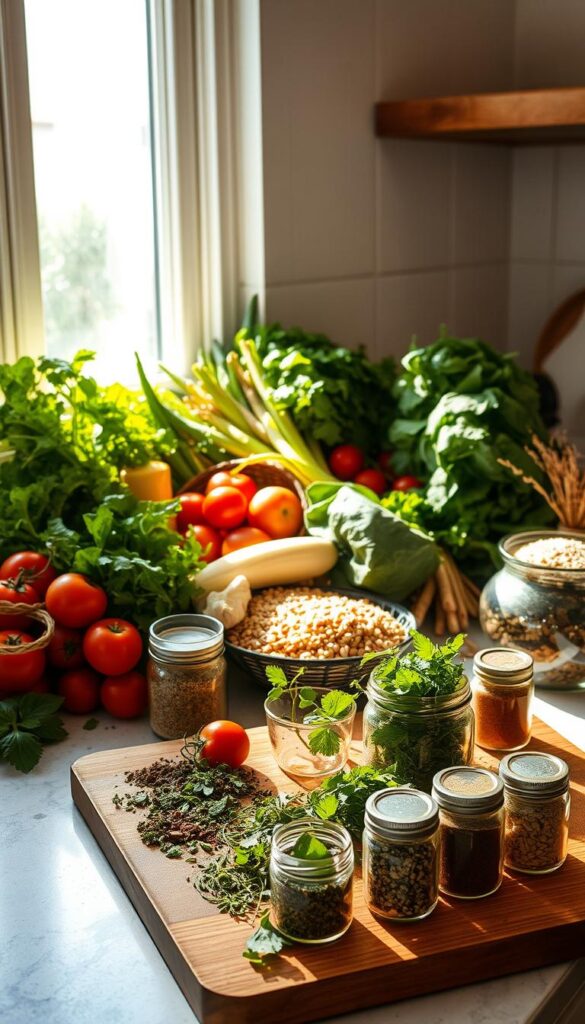
Key Takeaways
- Limit added sugars, saturated fats, and sodium to reduce risks of heart disease, diabetes, and obesity.
- Processed foods contribute over 70% of Americans’ sodium intake.
- Replace saturated fats like butter with unsaturated fats like olive oil for heart health.
- Choose whole foods over ultra-processed items linked to higher disease risks.
- Moderate alcohol intake to avoid liver strain and blood pressure spikes.
Added sugars hide in snacks, sodas, and even sauces. Too much sugar can lead to obesity and diabetes. The Dietary Guidelines suggest cutting back to protect your teeth and weight.
Saturated fats in fatty meats, butter, and full-fat dairy raise cholesterol. Switch to plant-based oils or fish for heart health. Opt for lean proteins like beans or poultry.
Processed foods like pizza and deli meats are high in sodium. Too much salt can raise blood pressure, a major risk factor for stroke. Cooking at home helps control salt levels.
Excessive alcohol harms the liver and raises blood pressure. Women should be limited to one drink daily, and men to two. Pair moderation with nutrient-rich meals for balance.
Making mindful choices like swapping chips for veggies or choosing whole grains over refined carbs keeps healthy eating simple. Small changes add up to big health wins.
Added Sugars: Avoid soft drinks, candies, and high-sugar desserts to prevent weight gain and diabetes

Added sugars are hidden in many foods, making it hard to stay within limits. The average American eats 17 teaspoons of sugar every day, which is twice what we should. Sugary drinks account for 47% of our sugar intake.
Identifying Hidden Sugar Sources
Don’t just look at obvious sweets: added sugars are in many other foods, too. Here’s how to find them:
- Cranberry juice cocktail: 31g sugar (7.75 tsp) per cup
- Flavored yogurt: 24g sugar vs. 8g in plain yogurt
- Granola bars: Up to 12g sugar per bar
| Product | Sugar Content | Healthier Swap |
|---|---|---|
| Packaged fruit smoothie | 35g | Homemade blend with spinach + banana |
| Chocolate milk | 26g per cup | Plain milk + berries |
| Pre-sweetened oatmeal | 12g per packet | Plain oats + apple slices |
“Added sugars displace nutrient-rich foods critical for energy and immunity.” – Dietary Guidelines for Americans 2020–2025
Drink water, eat nuts, or have fruit to stop sugar cravings. Cutting out sugary drinks can help you lose up to 5 pounds a year. Choose whole foods like apples over candy bars. Small changes can make a big difference.
Refined Grains: Skip white bread, pasta, and pastries made from refined flour to avoid unnecessary weight gain
Starting with dietary balance means choosing whole grains over refined ones. White bread and pasta lose fiber and nutrients, leaving only empty calories, which can raise blood sugar levels. The Dietary Guidelines for Americans recommend that half your grains should be whole, but most people don’t meet this goal.
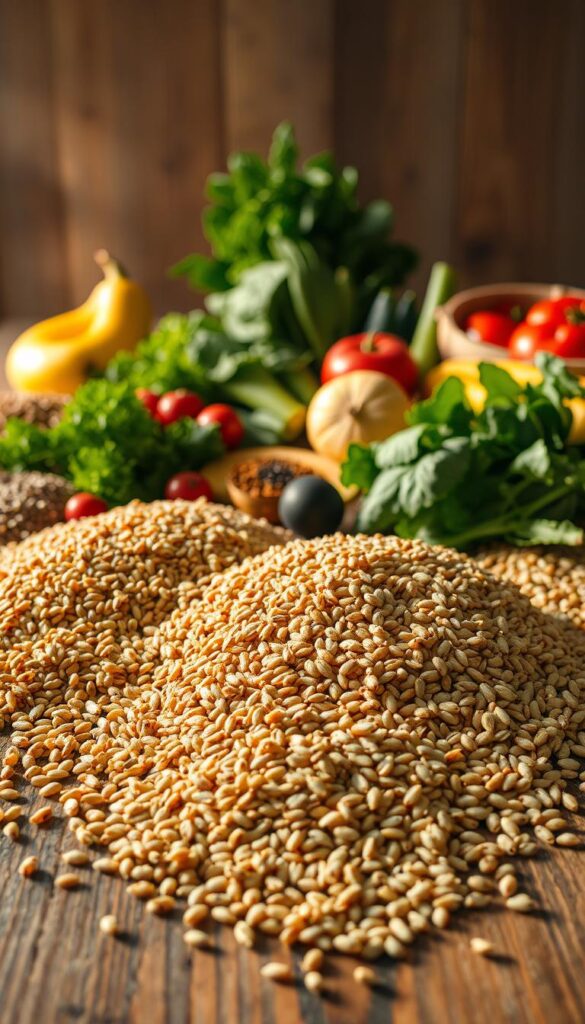
- Look for labels stating “100% whole grain” or check ingredient lists for whole wheat, oats, or quinoa as the first ingredient.
- Gradually swap: Mix half white rice with brown rice, or use whole-wheat pasta in recipes.
- Snack on whole-grain crackers instead of refined chips.
Consuming 70 grams of whole grains daily lowers total mortality risk by 22%, per a study of 700,000 people.
Whole grains like brown rice or barley offer B vitamins and fiber. They help you feel full longer, reducing the urge to overeat. Studies show switching to whole grains can lower diabetes risk by 36%. Making small changes, like choosing whole-wheat bread, can lead to better dietary balance.
Begin with one swap each week, like oatmeal for sugary cereal. Over time, you’ll enjoy sustained energy and nutrient-rich choices.
Excessive Salt: Limit high-sodium processed foods like canned soups and frozen meals to reduce the risk of hypertension
Most Americans eat too much sodium, about 1,100 milligrams more than they should. This can lead to high blood pressure and heart disease. Over 70% of this sodium comes from foods like pizza, sandwiches, and soups. Even bread and poultry have hidden salt.
To make well-balanced meals, try simple swaps and smart choices. This can help you eat healthier.
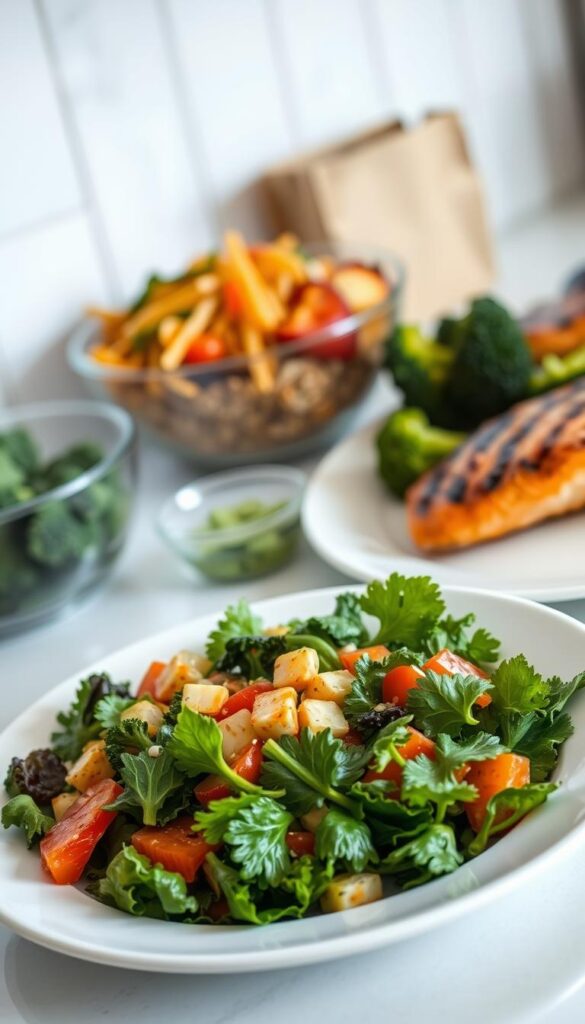
- Rinse canned beans to cut sodium by 40%.
- Use herbs like basil or garlic instead of salt.
- Choose frozen veggies without added sauces.
- Request no extra salt when dining out.
| High-Sodium Picks | Low-Sodium Swaps |
|---|---|
| Pizza | Homemade with low-sodium sauce |
| Canned soups | Make broth from scratch |
| Processed meats | Grilled chicken or beans |
The well-balanced meals approach is similar to the DASH diet. It’s been shown to lower blood pressure. Studies say cutting salt can reduce heart risks by 30%.
Small changes like cooking at home and using spices can add flavor without salt. Your heart—and taste buds—will thank you!
Saturated and Trans Fats: Steer clear of butter, margarine, fast food, and processed snacks to lower cholesterol and heart disease risk
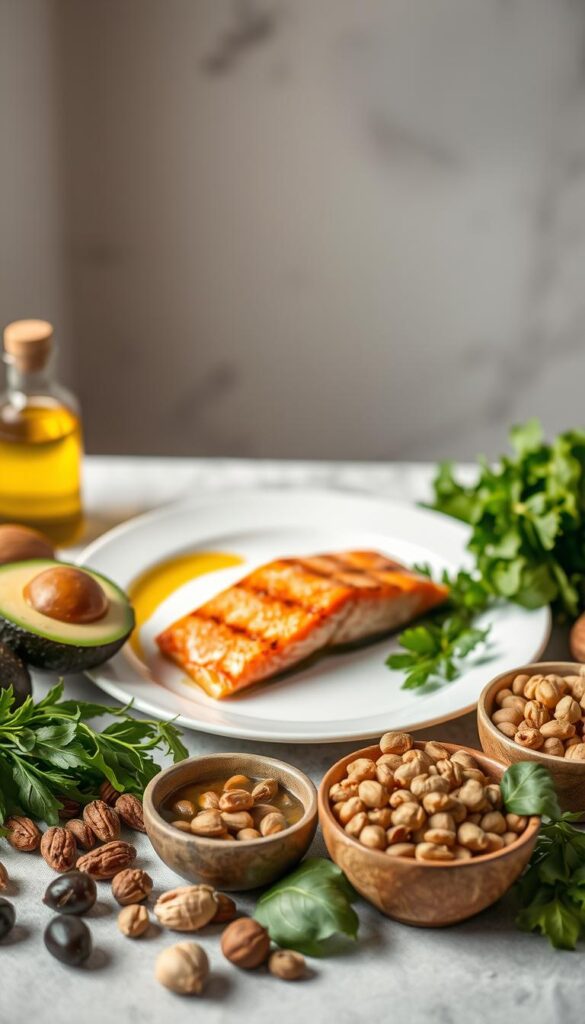
A smart nutrition plan means cutting down on saturated and trans fats. These fats can increase LDL cholesterol and heart disease risks. The FDA’s 2006 rule requires labels to list trans fats. But, many processed snacks still hide them in small amounts. Even a little bit can add up!
“Replacing unhealthy fats with unsaturated options can reduce heart disease risk by 30%.”
| Unhealthy Choice | Healthier Swap | Why It Helps |
|---|---|---|
| Stick margarine | Soft tub margarine (e.g., I Can’t Believe It’s Not Butter) | No trans fats, fewer calories |
| Butter in cooking | Olive or canola oil | Rich in heart-healthy monounsaturated fats |
| Fast-food fries | Baked sweet potato wedges | Cuts trans fats by 100% |
Find nutrition plan swaps like these. For example:
- Replace 1 tbsp butter (7g sat fat) with olive oil (0g sat fat)
- Choose grilled chicken instead of fried—cuts artery-clogging trans fats
Important limits: Keep saturated fats under 10% of daily calories. For a 2,000-calorie diet, that’s 120 calories max. Always check labels: “0g trans fat” means up to 0.5g/serving. Add up multiple servings!
Follow these heart-healthy nutrition plan rules:
- Use spreads without “partially hydrogenated oils” in ingredients
- Opt for nuts/seeds instead of processed snacks
- Choose ground turkey breast over fatty cuts of beef
Alcohol: If consumed, limit intake to one drink per day for women and two for men to avoid liver and other health issues

Knowing how alcohol affects health is key to good diet habits. Women should have no more than one drink a day. Men can have up to two. Drinking more can harm the liver and raise the risk of cancer, heart disease, and addiction.
| Drink Type | Standard Serving |
|---|---|
| Beer | 12 oz (5% alcohol) |
| Wine | 5 oz (12% alcohol) |
| Spirits | 1.5 oz (40% alcohol) |
Every standard drink has 14 grams of alcohol. The number of calories varies:
- A 12-oz beer: 150 calories
- 5-oz wine: 120 calories
- 1.5-oz spirits: 100 calories
- Mixed drinks: up to 500 calories
Research suggests that even moderate drinking might not lower death risk as much as not drinking at all. It’s important to be mindful of alcohol intake.
For making better choices:
- Keep track of your drinks to stay within limits
- Opt for light beers or wine instead of sugary cocktails
- Drink water with your alcohol to stay hydrated
- Talk to a doctor if you’re on medications or managing health conditions
Good diet habits are all about balance. Focus on eating nutrient-rich foods and limit alcohol to recommended amounts for better health in the long run.
Tips for a Balanced Diet
Meal planning makes healthy eating easy. Start by meal planning weekly to mix flavors and nutrients. Here’s how to simplify balance:
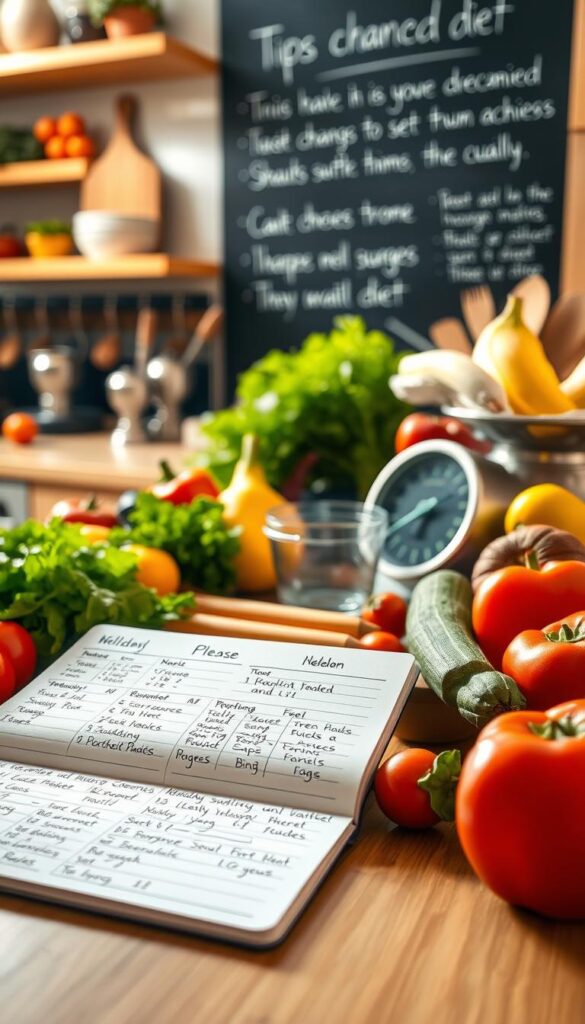
- Prioritize variety: Rotate protein, grains, and veggies to avoid boredom. Try new recipes or swap ingredients weekly.
- Plan portions: Fill half your plate with veggies and fruit (as per dietary guidelines), a quarter with whole grains, and a quarter with protein.
- Adjust for preferences: Choose foods that fit your culture and budget. For example, swap white rice for quinoa or try plant-based proteins like lentils.
- Limit saturated fats: Check labels to stay under 20-30g daily. Opt for olive oil over butter and choose lean meats.
- Stay flexible: Allow occasional treats, but focus on nutrient-rich choices 80% of the time. Small changes like swapping soda for water add up.
Balance isn’t about perfection. Use meal planning to create habits that work for your lifestyle. Remember: a balanced plate supports energy and long-term health better than strict diets.
Plan Your Meals: Helps manage portions and reduces unhealthy eating
Meal planning is a simple way to keep a balanced diet and avoid unhealthy choices. Spend 30–60 minutes each week planning meals and snacks. This helps you stay prepared and avoid fast food or large portions.
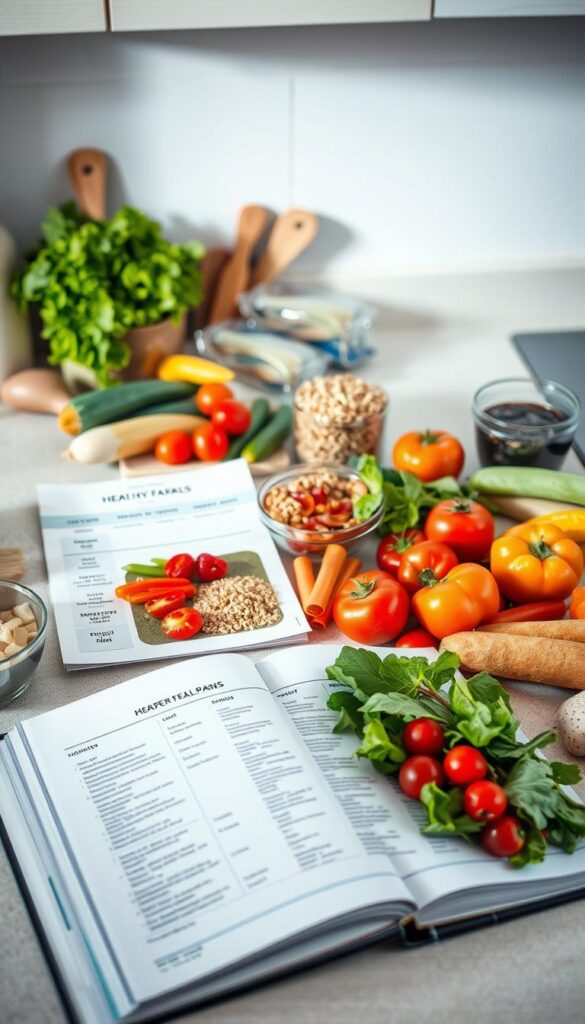
Meal planning increases the likelihood of making healthier food choices, according to registered dietitian Silvia Veri.
Creating a Weekly Meal Schedule
Start by checking what ingredients you have. Then, pick 3–4 main meals for the week, balancing protein, veggies, and whole grains. Make a grocery list to avoid impulse buys and stay on track with your meal planning goals. Prepare ingredients like chopping veggies or marinating proteins in advance to make cooking easier later.
- Inventory Check: Audit the pantry and fridge to avoid duplicates.
- Choose Recipes: Pick 3–4 main meals to simplify shopping and cooking.
- Prep Ahead: Chop veggies or cook grains in bulk for quick assembly later.
- Adjust Flexibly: Allow room for changes if plans shift unexpectedly.
| Benefit | How It Works |
|---|---|
| Saves Time | Reduces decision fatigue and last-minute scrambling. |
| Cuts Costs | Avoids overbuying and minimizes food waste. |
| Boosts Health | Makes room for whole foods, aligning with USDA MyPlate guidelines. |
Start small: Begin with three dinners a week and grow from there. Use apps or paper planners to track your progress. Remember, meal planning isn’t about being perfect—it’s about creating a framework that fits your lifestyle. By planning ahead, you’re more likely to stick to your goals and avoid oversized restaurant portions or sugary snacks.
Stay Hydrated: Drinking water is essential throughout the day

Your body needs water for many things, like carrying nutrients and keeping your heart beating. Drinking enough water is a crucial part of healthy eating that’s often forgotten. Here’s how to make it a daily habit:
“Athletes losing just 2% of body water see drops in focus and energy.”
Signs Your Body Needs More Fluid
- Dry mouth or chapped lips
- Dark yellow urine (aim for pale or clear)
- Headaches or dizziness
- Feeling unusually tired
Simple steps make a big difference:
- Carry a reusable bottle filled with water—add lemon or cucumber slices for flavor.
- Drink a glass first thing in the morning and before meals.
- Track intake using apps or marked water bottles.
Water isn’t the only choice. Herbal teas, low-sugar fruits (like watermelon), and even soups count. Avoid sugary drinks too much—stick to 1 small juice serving daily. And remember: thirst isn’t always a reliable signal. By the time you feel thirsty, you’re already slightly dehydrated.
Pro tip: Pregnant? Exercising? Add extra water. A 2013 study showed overweight women who drank 16.9 oz (0.5L) before meals lost 44% more weight than those who didn’t. Small changes add up!
Read Labels: Knowing nutritional information aids in making healthier choices
Starting good diet habits means knowing what’s in your food. The FDA updated Nutrition Facts labels in 2016. They now show added sugars and servings per package. A study found that 68.8% of those on diets check labels often, compared to 56.8% of others.
These small steps make shopping a way to improve your health.
Deciphering Ingredient Lists and Nutrition Facts
Choose foods with short ingredient lists that prioritize whole foods. Avoid products with many added sugars. The % Daily Value (%DV) tells you whether a food is high or low in nutrients.
Look for foods with at least 3g of fiber per serving and sodium under 2300 mg daily. A 2000-calorie diet is a good starting point, but adjust it to your activity level.
Focus on vitamins like calcium and vitamin D, which are often lacking. Opt for snacks with 100 calories or less per serving. Over 62% of those who tracked their diet showed better nutrition knowledge.
Choose foods with plant-based ingredients and few additives. Making small changes in shopping can lead to lasting good diet habits. These habits protect your heart health and energy levels.






